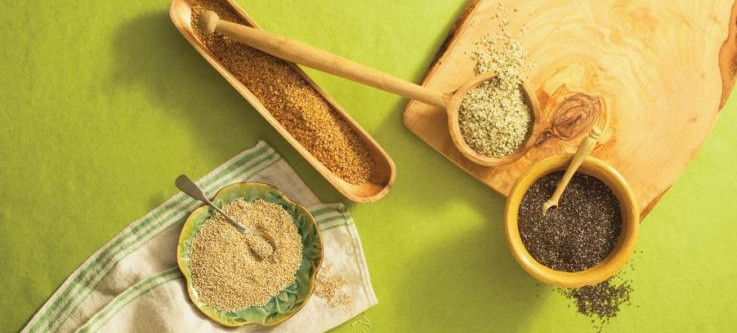Small but mighty, seeds have worked their way onto the radar of many a health-conscious consumer. Expert sources such as Dr. Oz and the The New York Times have recently declared seeds among the world’s “superfoods”—nutrient- and phytochemical-dense dietary wonders that provide you with a flood of nutrients in compact doses. Seeds have been a staple in many world diets for centuries, if not millennia. Quinoa and chia seeds provided sustenance for many Native American cultures, including the Aztec and Inca. Ancient Mesopotamian cultures incorporated flax into their textiles and diets, and during the same era, hemp seeds helped Himalayan tribes grow and prosper.
Most seeds—whether whole, ground, pressed into oil or incorporated into bars, cereals and supplements—are available year-round in the natural-food section of your local market.
FLAX
Native to the Middle East, flax provided ancient cultures with food, medicine and textile fibers.

PREP IT: To get the full nutritional benefits of flax, purchase the seeds whole and grind them in a coffee grinder yourself before sprinkling them over cereal or blending them into a yogurt-and-fruit smoothie. You can also stir them into pancake mix.
BONUS: Recent evidence suggests that consuming flaxseed— high in phytoestrogens— may decrease risk of hormone-dependent cancers, such as breast, uterine and ovarian.
RDA PROFILE: omega-3 (290%), thiamin (28%), fiber (14%)
RECIPE: Jen’s Mother’s Day Self-Care Smoothie
TRY: 365 Everyday Value, Organic Brown Flaxseed
QUINOA

PREP IT: Delicious raw or cooked (boiled or baked), it’s an ideal replacement for rice and other grains.
BONUS: Higher in antioxidant content than most berries.
RDA PROFILE: magnesium (37%), iron (50%), zinc (23%)
RECIPE: Salmon & Kale Quinoa Salad
TRY: Spectrum Essentials Organic Ground Flaxseed
HEMP
Yes, hemp is related to marijuana, but hemp seeds do not induce intoxication because they are bred for low or no THC
PREP IT: Sprinkle hemp on salads, stir-fries, yogurt or oatmeal or incorporate it with your favorite baked treats. Its nutty flavor also makes it ideal in oil or hemp nut butter.
BONUS: Hemp is the most readily digestible plant protein because it contains no enzyme inhibitors.
RDA PROFILE: iron (606%)
RECIPE: Cherry Cobbler Smoothie Bowl
TRY: Nutiva Organic, Raw, Shelled Hempseed
CHIA

PREP IT: Combine chia with quinoa, hemp seeds and a few other ingredients for a low-fat variation on granola or trail mix, or add it to your water when you’re working out—it absorbs 12 times its weight in water, which means your body gets more bang for its hydration buck.
BONUS: The seed has five times more calcium than cow’s milk and more antioxidants than blueberries.
RDA PROFILE: omega-3 (226%), iron (26%), magnesium (21%)
RECIPE: Spiced Coconut Chia Pudding

